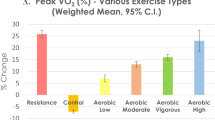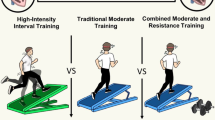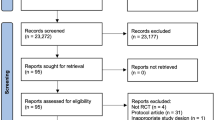Abstract
Aerobic training (AT) has been the primary mode of exercise training in cardiac rehabilitation. Historically, the reason for the prescription of AT was that it was speculated that although RT may be beneficial for some clinical outcomes, it may have an adverse effect on ventricular structure and function. However, RT has now made its way into current cardiac rehabilitation guidelines, including those directed towards patients with HF, albeit differences exist across institutions and guidelines. A systematic search of PubMed, EMBASE and Cochrane Trials Register on April 30, 2021, was conducted for exercise-based rehabilitation trials in HF. Randomised and controlled trials that reported on resistance training versus usual care or trials that directly compared RT to an AT intervention were included. Resistance training versus controls improves parameters of lower (SMD 0.76 (95%CI 0.26, 1.25, p = 0.003] and upper extremity muscle strength (SMD 0.85 (95%CI 0.35, 1.35), p = 0.0009], both key parameters of physical function throughout the lifespan. Importantly, RT in isolation, versus control, improves VO2peak [MD: 2.64 ml/kg/min (95%CI 1.67, 3.60), p < 0.00001] and 6MWD [MD: 49.94 m (95%CI 34.59, 65.29), p < 0.00001], without any detrimental effect on left ventricular parameters. Resistance training in HF patients is safe and improves parameters of physical function and quality of life. Where people with HF are unable to, or are not inclined to, partake in aerobic activity, RT alone is appropriate to elicit meaningful benefit.




Similar content being viewed by others
Availability of data and materials
Not applicable.
Code availability
Not applicable.
References
Taylor RS, Walker S, Smart NA, Piepoli MF, Warren FC, Ciani O et al (2019) Impact of exercise rehabilitation on exercise capacity and quality-of-life in heart failure: individual participant meta-analysis. J Am Coll Cardiol 73(12):1430–1443
Dieberg G, Ismail H, Giallauria F, Smart NA (2015) Clinical outcomes and cardiovascular responses to exercise training in heart failure patients with preserved ejection fraction: a systematic review and meta-analysis. J Appl Physiol 119(6):726–733
Long L, Mordi IR, Bridges C, Sagar VA, Davies EJ, Coats AJ et al (2019) Exercise‐based cardiac rehabilitation for adults with heart failure. Cochrane Database of Systematic Reviews (1)
Pearson M, Mungovan S, Smart N (2017) Effect of exercise on diastolic function in heart failure patients: a systematic review and meta-analysis. Heart Fail Rev 22(2):229–242
Pearson M, Smart N (2018) Exercise therapy and autonomic function in heart failure patients: a systematic review and meta-analysis. Heart Fail Rev 23(1):91–108
Pearson M, Smart N (2017) Effect of exercise training on endothelial function in heart failure patients: a systematic review meta-analysis. Int J Cardiol 231:234–243
Ismail H, McFarlane JR, Nojoumian AH, Dieberg G, Smart NA (2013) Clinical outcomes and cardiovascular responses to different exercise training intensities in patients with heart failure: a systematic review and meta-analysis. JACC: Heart Failure 1(6):514–22
Tucker WJ, Beaudry RI, Liang Y, Clark AM, Tomczak CR, Nelson MD et al (2019) Meta-analysis of exercise training on left ventricular ejection fraction in heart failure with reduced ejection fraction: a 10-year update. Prog Cardiovasc Dis 62(2):163–171
Tucker WJ, Haykowsky MJ, Seo Y, Stehling E, Forman DE (2018) Impaired exercise tolerance in heart failure: role of skeletal muscle morphology and function. Curr Heart Fail Rep 15(6):323–331
Carbone S, Billingsley HE, Rodriguez-Miguelez P, Kirkman DL, Garten R, Franco RL et al (2019) Lean mass abnormalities in heart failure: the role of sarcopenia, sarcopenic obesity, and cachexia. Curr Probl Cardiol 100417
Ventura HO, Carbone S, Lavie CJ (2018) Muscling up to improve heart failure prognosis. Wiley Online Library
Lavie CJ, Carbone S, Neeland IJ (2020) Prevention and treatment of heart failure: we want to pump you up. American College of Cardiology Foundation Washington DC
Brubaker PH, Tucker WJ, Haykowsky MJ (2020) Clinical Considerations and exercise responses of patients with heart failure and preserved ejection fraction: what have we learned in 20 years? Journal of Clinical Exercise Physiology 9(1):17–28
Kitzman DW, Whellan DJ, Duncan P, Pastva AM, Mentz RJ, Reeves GR et al (2021) Physical rehabilitation for older patients hospitalized for heart failure. New England Journal of Medicine
Schoenfeld BJ, Grgic J, Van Every DW, Plotkin DL (2021) Loading recommendations for muscle strength, hypertrophy, and local endurance: a re-examination of the repetition continuum. Sports 9(2):32
World Health Organization (2010) t. Global recommendations on physical activity for health: World Health Organization
Garber CE, Blissmer B, Deschenes MR, Franklin BA, Lamonte MJ, Lee I-M et al (2011) American College of Sports Medicine position stand. Quantity and quality of exercise for developing and maintaining cardiorespiratory, musculoskeletal, and neuromotor fitness in apparently healthy adults: guidance for prescribing exercise. Medicine and science in sports and exercise 43(7):1334–59
Piercy KL, Troiano RP, Ballard RM, Carlson SA, Fulton JE, Galuska DA et al (2018) The physical activity guidelines for Americans. JAMA 320(19):2020–2028
Fragala MS, Cadore EL, Dorgo S, Izquierdo M, Kraemer WJ, Peterson MD et al (2019) Resistance training for older adults: position statement from the national strength and conditioning association. J Strength Cond Res 33(8):2019–2052
Grgic J, Garofolini A, Orazem J, Sabol F, Schoenfeld BJ, Pedisic Z (2020) Effects of resistance training on muscle size and strength in very elderly adults: a systematic review and meta-analysis of randomized controlled trials. Sports Medicine 1–17
Sharman JE, Smart NA, Coombes JS, Stowasser M (2019) Exercise and sport science australia position stand update on exercise and hypertension. Journal of human hypertension 1–7
Hayes SC, Newton RU, Spence RR, Galvão DA (2019) The Exercise and Sports Science Australia position statement: exercise medicine in cancer management. J Sci Med Sport 22(11):1175–1199
Hordern MD, Dunstan DW, Prins JB, Baker MK, Singh MAF, Coombes JS (2012) Exercise prescription for patients with type 2 diabetes and pre-diabetes: a position statement from Exercise and Sport Science Australia. J Sci Med Sport 15(1):25–31
Carbone S, Kirkman DL, Garten RS, Rodriguez-Miguelez P, Artero EG, Lee D-c et al (2020) Muscular strength and cardiovascular disease: an updated state-of-the-art narrative review. Journal of Cardiopulmonary Rehabilitation and Prevention 40(5):302–9
Schoenfeld BJ, Ogborn D, Krieger JW (2017) Dose-response relationship between weekly resistance training volume and increases in muscle mass: a systematic review and meta-analysis. J Sports Sci 35(11):1073–1082
Jadczak AD, Makwana N, Luscombe-Marsh N, Visvanathan R, Schultz TJ (2018) Effectiveness of exercise interventions on physical function in community-dwelling frail older people: an umbrella review of systematic reviews. JBI Evidence Synthesis 16(3):752–775
Gordon BR, McDowell CP, Hallgren M, Meyer JD, Lyons M, Herring MP (2018) Association of efficacy of resistance exercise training with depressive symptoms: meta-analysis and meta-regression analysis of randomized clinical trials. JAMA Psychiat 75(6):566–576
Saeidifard F, Medina-Inojosa JR, West CP, Olson TP, Somers VK, Bonikowske AR et al (2019) The association of resistance training with mortality: A systematic review and meta-analysis. Eur J Prev Cardiol 26(15):1647–1665
Price KJ, Gordon BA, Bird SR, Benson AC (2016) A review of guidelines for cardiac rehabilitation exercise programmes: is there an international consensus? Eur J Prev Cardiol 23(16):1715–1733
McKelvie RS, McCartney N, Tomlinson C, Bauer R, MacDougall JD (1995) Comparison of hemodynamic responses to cycling and resistance exercise in congestive heart failure secondary to ischemic cardiomyopathy. Am J Cardiol 76(12):977–979
Maiorana AJ, Naylor LH, Exterkate A, Swart A, Thijssen DH, Lam K et al (2011) The impact of exercise training on conduit artery wall thickness and remodeling in chronic heart failure patients. Hypertension 57(1):56–62
Munch GW, Rosenmeier JB, Petersen M, Rinnov AR, Iepsen UW, Pedersen BK et al (2018) Comparative effectiveness of low-volume time-efficient resistance training versus endurance training in patients with heart failure. J Cardiopulm Rehabil Prev 38(3):175–181
Pollock ML, Franklin BA, Balady GJ, Chaitman BL, Fleg JL, Fletcher B et al (2000) Resistance exercise in individuals with and without cardiovascular disease: benefits, rationale, safety, and prescription an advisory from the committee on exercise, rehabilitation, and prevention, council on clinical cardiology. American Heart Association Circulation 101(7):828–833
Selig SE, Levinger I, Williams AD, Smart N, Holland DJ, Maiorana A et al (2010) Exercise & Sports Science Australia Position Statement on exercise training and chronic heart failure. J Sci Med Sport 13(3):288–294
Shoemaker MJ, Dias KJ, Lefebvre KM, Heick JD, Collins SM (2020) Physical therapist clinical practice guideline for the management of individuals with heart failure. Phys Ther 100(1):14–43
Ambrosetti M, Abreu A, Corrà U, Davos CH, Hansen D, Frederix I et al (2020) Secondary prevention through comprehensive cardiovascular rehabilitation: from knowledge to implementation. 2020 update. A position paper from the Secondary Prevention and Rehabilitation Section of the European Association of Preventive Cardiology. European journal of preventive cardiology 2047487320913379
Liguori G, Medicine ACoS. ACSM’s guidelines for exercise testing and prescription: Lippincott Williams & Wilkins; 2020.
Jewiss D, Ostman C, Smart NA (2016) The effect of resistance training on clinical outcomes in heart failure: a systematic review and meta-analysis. Int J Cardiol 221:674–681
Giuliano C, Karahalios A, Neil C, Allen J, Levinger I (2017) The effects of resistance training on muscle strength, quality of life and aerobic capacity in patients with chronic heart failure - a meta-analysis. Int J Cardiol 227:413–423
Hansen D, Abreu A, Doherty P, Völler H (2019) Dynamic strength training intensity in cardiovascular rehabilitation: is it time to reconsider clinical practice? A systematic review. Eur J Prev Cardiol 26(14):1483–1492
Lavie CJ, Carbone S, Neeland IJ (2021) Prevention and treatment of heart failure: we want to pump you up. American College of Cardiology Foundation Washington DC
Liberati A, Altman DG, Tetzlaff J, Mulrow C, Gøtzsche PC, Ioannidis JP et al (2009) The PRISMA statement for reporting systematic reviews and meta-analyses of studies that evaluate health care interventions: explanation and elaboration. J Clin Epidemiol 62(10):e1–e34
Moher D, Liberati A, Tetzlaff J, Altman DG, Group P (2009) Preferred reporting items for systematic reviews and meta-analyses: the PRISMA statement. PLoS med 6(7):e1000097
Weir CJ, Butcher I, Assi V, Lewis SC, Murray GD, Langhorne P et al (2018) Dealing with missing standard deviation and mean values in meta-analysis of continuous outcomes: a systematic review. BMC Med Res Methodol 18(1):1–14
Higgins JP, Thomas J, Chandler J, Cumpston M, Li T, Page MJ et al (2019) Cochrane handbook for systematic reviews of interventions: John Wiley & Sons
Higgins JP, Thompson SG, Deeks JJ, Altman DG (2003) Measuring inconsistency in meta-analyses. BMJ 327(7414):557–560
Valentine JC, Pigott TD, Rothstein HR (2010) How many studies do you need? A primer on statistical power for meta-analysis. Journal of Educational and Behavioral Statistics 35(2):215–247
Wan X, Wang W, Liu J, Tong T (2014) Estimating the sample mean and standard deviation from the sample size, median, range and/or interquartile range. BMC Med Res Methodol 14(1):135
Thompson B (1998) Statistical significance and effect size reporting: portrait of a possible future. Res Sch 5(2):33–38
Higgins JP, Thompson SG (2002) Quantifying heterogeneity in a meta-analysis. Stat Med 21(11):1539–1558
Higgins J, Green S (2008) Cochrane handbook for systematic reviews. The Cochrane Collaboration 5(0)
Simmonds M (2015) Quantifying the risk of error when interpreting funnel plots. Syst Rev 4(1):24
Smart NA, Waldron M, Ismail H, Giallauria F, Vigorito C, Cornelissen V et al (2015) Validation of a new tool for the assessment of study quality and reporting in exercise training studies: TESTEX. Int J Evid Based Healthc 13(1):9–18
Cider A, Tygesson H, Hedberg M, Seligman L, Wennerblom B, Sunnerhagen KS (1997) Peripheral muscle training in patients with clinical signs of heart failure. Scand J Rehabil Med 29(2):121–127
Feiereisen P, Delagardelle C, Vaillant M, Lasar Y, Beissel J (2007) Is strength training the more efficient training modality in chronic heart failure? Med Sci Sports Exerc 39(11):1910–1917
Groennebaek T, Sieljacks P, Nielsen R, Pryds K, Jespersen NR, Wang J et al (2019) Effect of blood flow restricted resistance exercise and remote ischemic conditioning on functional capacity and myocellular adaptations in patients with heart failure. Circ Heart Fail 12(12):e006427
Grosse T, Kreulich K, Nägele H, Reer R, Petersen B, Braumann K et al (2001) Peripheres Muskelkrafttraining bei schwerer Herzinsuffizienz. Deutsche Zeitschrift für Sportmedizin 52(1)
Jakovljevic DG, Donovan G, Nunan D, McDonagh S, Trenell MI, Grocott-Mason R et al (2010) The effect of aerobic versus resistance exercise training on peak cardiac power output and physical functional capacity in patients with chronic heart failure. Int J Cardiol 145(3):526–528
Koch M, Douard H, Broustet JP (1992) The benefit of graded physical exercise in chronic heart failure. Chest 101(5 Suppl):231s-s235
Lan NS, Lam K, Naylor LH, Green DJ, Minaee NS, Dias P et al (2020) The impact of distinct exercise training modalities on echocardiographic measurements in patients with heart failure with reduced ejection fraction. J Am Soc Echocardiogr 33(2):148–156
Levinger I, Bronks R, Cody DV, Linton I, Davie A (2005a) Resistance training for chronic heart failure patients on beta blocker medications. Int J Cardiol 102(3):493–499
Levinger I, Bronks R, Cody DV, Linton I, Davie A (2005b) The effect of resistance training on left ventricular function and structure of patients with chronic heart failure. Int J Cardiol 105(2):159–163
Palevo G, Keteyian SJ, Kang M, Caputo JL (2009) Resistance exercise training improves heart function and physical fitness in stable patients with heart failure. J Cardiopulm Rehabil Prev 29(5):294–298
Pu CT, Johnson MT, Forman DE, Hausdorff JM, Roubenoff R, Foldvari M et al (2001) Randomized trial of progressive resistance training to counteract the myopathy of chronic heart failure. J Appl Physiol 90(6):2341–2350
Redwine LS, Wilson K, Pung MA, Chinh K, Rutledge T, Mills PJ et al (2019) A randomized study examining the effects of mild-to-moderate group exercises on cardiovascular, physical, and psychological well-being in patients with heart failure. J Cardiopulm Rehabil Prev 39(6):403–408
Sadek Z, Ahmaidi S, Youness M, Joumaa W, Awada C, Ramadan W (2018) editors. Impact of resistance training in patients with chronic heart failure. The Seventh International Conference on Global Health Challenges, Athens, Greece
Selig SE, Carey MF, Menzies DG, Patterson J, Geerling RH, Williams AD et al (2004) Moderate-intensity resistance exercise training in patients with chronic heart failure improves strength, endurance, heart rate variability, and forearm blood flow. J Cardiac Fail 10(1):21–30
Tyni-Lenné R, Dencker K, Gordon A, Jansson E, Sylvén C (2001) Comprehensive local muscle training increases aerobic working capacity and quality of life and decreases neurohormonal activation in patients with chronic heart failure. Eur J Heart Fail 3(1):47–52
Savage P, Shaw AO, Miller MS, VanBuren P, LeWinter MM, Ades PA et al (2011) Effect of resistance training on physical disability in chronic heart failure. Med Sci Sports Exerc 43(8):1379
Lee CJ, Ryu HY, Chun KH, Oh J, Park S, Lee SH et al (2021) Association of muscular fitness with rehospitalization for heart failure with reduced ejection fraction. Clin Cardiol 44(2):244–251
Taylor RS, Walker S, Ciani O, Warren F, Smart NA, Piepoli M et al (2019) Exercise-based cardiac rehabilitation for chronic heart failure: the EXTRAMATCH II individual participant data meta-analysis. Health Technol Assess 23(25):1–98
Fidalgo ASF, Farinatti P, Borges JP, de Paula T, Monteiro W (2019) Institutional guidelines for resistance exercise training in cardiovascular disease: a systematic review. Sports Med 49(3):463–475
Kambič T, Novaković M, Tomažin K, Strojnik V, Jug B (2019) Blood flow restriction resistance exercise improves muscle strength and hemodynamics, but not vascular function in coronary artery disease patients: a pilot randomized controlled trial. Front Physiol 10:656
Cristina-Oliveira M, Meireles K, Spranger MD, O’Leary DS, Roschel H, Peçanha T (2020) Clinical safety of blood flow-restricted training? A comprehensive review of altered muscle metaboreflex in cardiovascular disease during ischemic exercise. American Journal of Physiology-Heart and Circulatory Physiology 318(1):H90–H109
Smart NA, Way D, Carlson D, Millar P, McGowan C, Swaine I et al (2019) Effects of isometric resistance training on resting blood pressure: individual participant data meta-analysis. J Hypertens 37(10):1927
A. Correia M, Oliveira PL, Farah BQ, Vianna LC, Wolosker N, Puech‐Leao P et al (2020) Effects of isometric handgrip training in patients with peripheral artery disease: a randomized controlled trial. J Am Heart Assoc 9(4):e013596
Hollings M, Mavros Y, Freeston J, Fiatarone SM (2017) The effect of progressive resistance training on aerobic fitness and strength in adults with coronary heart disease: a systematic review and meta-analysis of randomised controlled trials. Eur J Prev Cardiol 24(12):1242–1259
Haykowsky MJ, Liang Y, Pechter D, Jones LW, McAlister FA, Clark AM (2007) A meta-analysis of the effect of exercise training on left ventricular remodeling in heart failure patients: the benefit depends on the type of training performed. J Am Coll Cardiol 49(24):2329–2336
Canning KL, Hicks AL (2020) Benefits of adhering to the Canadian physical activity guidelines for adults with multiple sclerosis beyond aerobic fitness and strength. Int J MS Care 22(1):15–21
Gao M, Lu X, Chen W, Xiao GH, Zhang Y, Yu R, Li J (2018) Randomized clinical trial of physiological ischemic training for patients with coronary heart disease complicated with heart failure: Safety of training, VEGF of peripheral blood and quality of life. Exp Ther Med 16(1):260–264
Funding
No funding has been received for the work.
Author information
Authors and Affiliations
Contributions
All authors contributed to the study conception and design. Material preparation, data collection and analysis were performed by S Fisher and M Pearson. Study quality was assessed by S Fisher and N Smart. The first draft of the manuscript was written by S Fisher. M Pearson and N Smart revised and completed the manuscript. The authors read and approved the final manuscript.
Corresponding author
Ethics declarations
Ethics approval and consent to participate
Not applicable. Meta-analysis of published data.
Consent for publications
All authors consent to publication of this article.
Conflict of interest
The authors declare that they have no conflict of interest.
Additional information
Publisher's Note
Springer Nature remains neutral with regard to jurisdictional claims in published maps and institutional affiliations.
Supplementary Information
Below is the link to the electronic supplementary material.
Rights and permissions
About this article
Cite this article
Fisher, S., Smart, N.A. & Pearson, M.J. Resistance training in heart failure patients: a systematic review and meta-analysis. Heart Fail Rev 27, 1665–1682 (2022). https://doi.org/10.1007/s10741-021-10169-8
Accepted:
Published:
Issue Date:
DOI: https://doi.org/10.1007/s10741-021-10169-8




